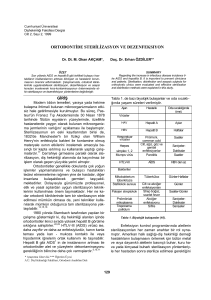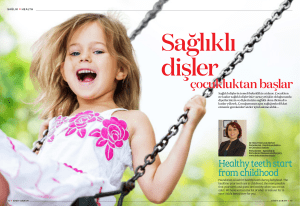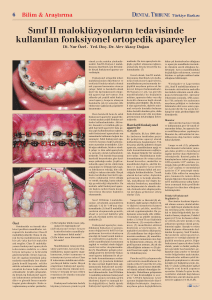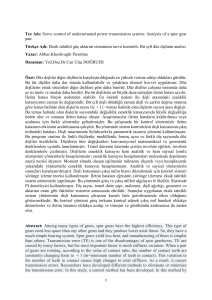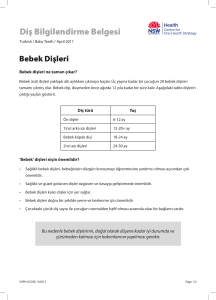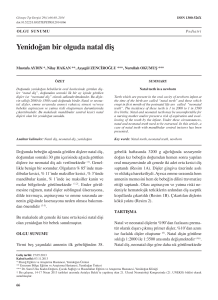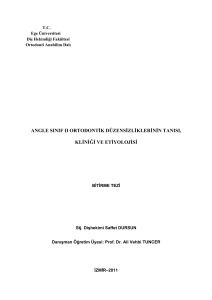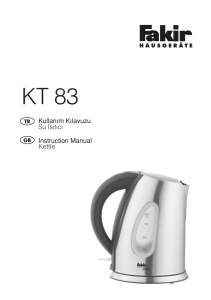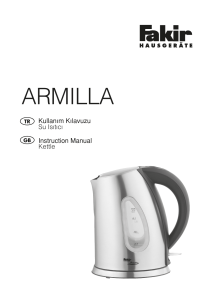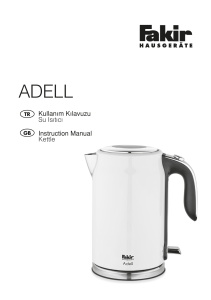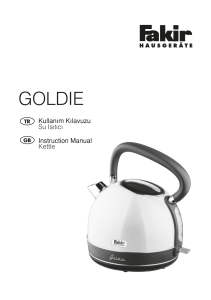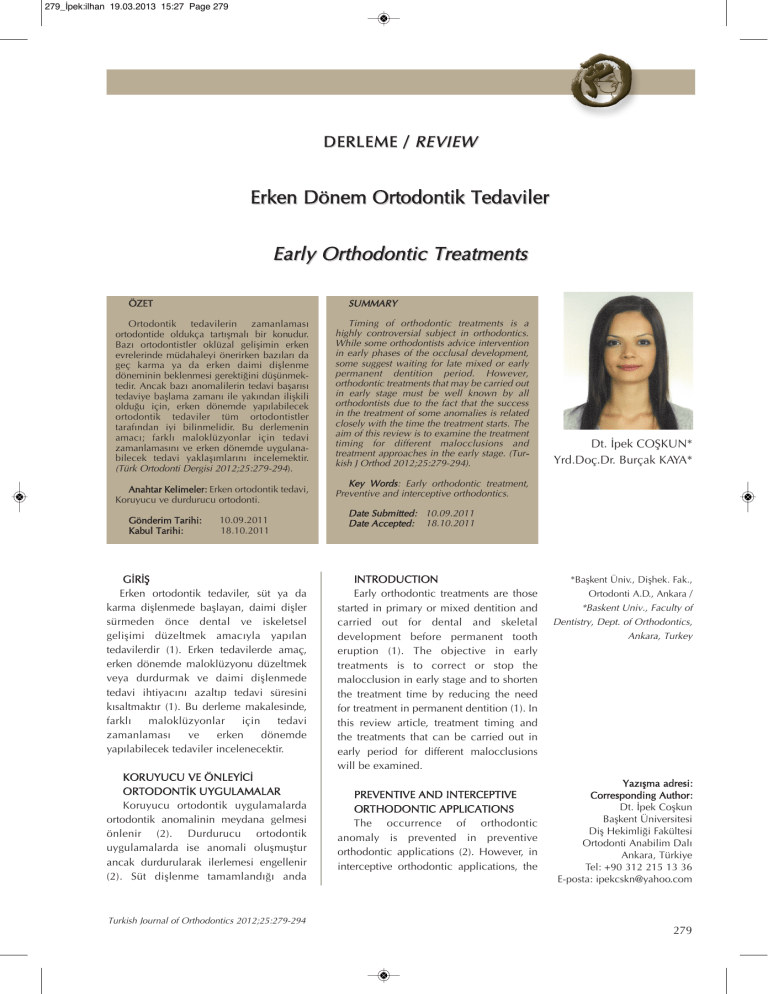
279_İpek:ilhan 19.03.2013 15:27 Page 279
DERLEME / REVIEW
Erken Dönem Ortodontik Tedaviler
Early Orthodontic Treatments
SUMMARY
ÖZET
Ortodontik tedavilerin zamanlaması
ortodontide oldukça tartışmalı bir konudur.
Bazı ortodontistler oklüzal gelişimin erken
evrelerinde müdahaleyi önerirken bazıları da
geç karma ya da erken daimi dişlenme
döneminin beklenmesi gerektiğini düşünmektedir. Ancak bazı anomalilerin tedavi başarısı
tedaviye başlama zamanı ile yakından ilişkili
olduğu için, erken dönemde yapılabilecek
ortodontik tedaviler tüm ortodontistler
tarafından iyi bilinmelidir. Bu derlemenin
amacı; farklı maloklüzyonlar için tedavi
zamanlamasını ve erken dönemde uygulanabilecek tedavi yaklaşımlarını incelemektir.
(Türk Ortodonti Dergisi 2012;25:279-294).
Anahtar Kelimeler: Erken ortodontik tedavi,
Koruyucu ve durdurucu ortodonti.
Gönderim Tarihi:
Kabul Tarihi:
10.09.2011
18.10.2011
G‹R‹fi
Erken ortodontik tedaviler, süt ya da
karma dişlenmede başlayan, daimi dişler
sürmeden önce dental ve iskeletsel
gelişimi düzeltmek amacıyla yapılan
tedavilerdir (1). Erken tedavilerde amaç,
erken dönemde maloklüzyonu düzeltmek
veya durdurmak ve daimi dişlenmede
tedavi ihtiyacını azaltıp tedavi süresini
kısaltmaktır (1). Bu derleme makalesinde,
farklı
maloklüzyonlar
için
tedavi
zamanlaması
ve
erken
dönemde
yapılabilecek tedaviler incelenecektir.
KORUYUCU VE ÖNLEYİCİ
ORTODONTİK UYGULAMALAR
Koruyucu ortodontik uygulamalarda
ortodontik anomalinin meydana gelmesi
önlenir (2). Durdurucu ortodontik
uygulamalarda ise anomali oluşmuştur
ancak durdurularak ilerlemesi engellenir
(2). Süt dişlenme tamamlandığı anda
Timing of orthodontic treatments is a
highly controversial subject in orthodontics.
While some orthodontists advice intervention
in early phases of the occlusal development,
some suggest waiting for late mixed or early
permanent dentition period. However,
orthodontic treatments that may be carried out
in early stage must be well known by all
orthodontists due to the fact that the success
in the treatment of some anomalies is related
closely with the time the treatment starts. The
aim of this review is to examine the treatment
timing for different malocclusions and
treatment approaches in the early stage. (Turkish J Orthod 2012;25:279-294).
Dt. İpek COŞKUN*
Yrd.Doç.Dr. Burçak KAYA*
Key Words: Early orthodontic treatment,
Preventive and interceptive orthodontics.
Date Submitted: 10.09.2011
Date Accepted: 18.10.2011
INTRODUCTION
Early orthodontic treatments are those
started in primary or mixed dentition and
carried out for dental and skeletal
development before permanent tooth
eruption (1). The objective in early
treatments is to correct or stop the
malocclusion in early stage and to shorten
the treatment time by reducing the need
for treatment in permanent dentition (1). In
this review article, treatment timing and
the treatments that can be carried out in
early period for different malocclusions
will be examined.
PREVENTIVE AND INTERCEPTIVE
ORTHODONTIC APPLICATIONS
The occurrence of orthodontic
anomaly is prevented in preventive
orthodontic applications (2). However, in
interceptive orthodontic applications, the
*Başkent Üniv., Dişhek. Fak.,
Ortodonti A.D., Ankara /
*Baskent Univ., Faculty of
Dentistry, Dept. of Orthodontics,
Ankara, Turkey
Yaz›flma adresi:
Corresponding Author:
Dt. İpek Coşkun
Başkent Üniversitesi
Diş Hekimliği Fakültesi
Ortodonti Anabilim Dalı
Ankara, Türkiye
Tel: +90 312 215 13 36
E-posta: [email protected]
Turkish Journal of Orthodontics 2012;25:279-294
279
279_İpek:ilhan 19.03.2013 15:27 Page 280
Coşkun, Kaya
başlayabilecek
koruyucu
ortodontik
uygulamalar şunlardır (3):
1. Diş çürüğü profilaksisi
2. Süt dişlerinin ara yüz çürüklerinde ark
uzunluğunun azalmaması için uygun
meziodistal boyutta dolgular yapılması ve
süt dişlerinin gerektiği sürece ağızda
tutulması
3. Süt dişleri erken kaybedildiğinde yer
tutucuların yapılması
4. Süt veya karma dişlenme döneminde
primer kontak yaratan sivri tüberküllerin
aşındırılması
5. Alt arkta sürekli kesici dişler sürdükten
sonra 1,5–2 mm yer darlığı görülüyorsa,
sürme rehberliği uygulanması
6. Anormal basınç alışkanlıklarının ikna
yoluyla
veya
çeşitli
apareylerle
engellenmesi
Süt Dişlenme Dönemindeki Anormal
Basınç Alışkanlıklarının Tedavileri
Anormal
basınç
alışkanlıklarının
ortodontik
maloklüzyonlara
neden
olabilmesi üç önemli faktöre bağlıdır. Bunlar
alışkanlığın süresi, sıklığı ve şiddetidir (4). Bir
alışkanlığın
maloklüzyon
meydana
getirebilmesi için aylar ile ifade edilebilecek
bir süre gereklidir. Bununla birlikte
alışkanlığın maloklüzyon oluşturabilmesi için
günün en az yarıya yakın bir zamanında
devam etmesi gerekir. Alışkanlık sırasında
uygulanan kuvvet ya da basınç miktarı da
maloklüzyon oluşmasında etkilidir (4). Süt
dişlenmede görülebilen anormal basınç
alışkanlıkları ve tedavi yöntemlerini şöyle
sıralayabiliriz;
1) Anormal dil büyüklüğü, pozisyonu ve
yutkunma: Anormal yutkunma refleksinin,
dilin infantil dönemdeki fonksiyonlarını
sürdürmesi
ve
matil
yutkunmaya
geçilememesi sonucu oluştuğu düşünülür.
Maloklüzyona
primer
olarak
dil
disfonksiyonunun mu neden olduğu yoksa dil
disfonksiyonunun istenmeyen bir morfolojik
adaptasyon sonucu mu geliştiği tartışmalıdır
(5). Schwarz’a göre dil açık kapanışı
yaratmaktan değil devam ettirmekten
sorumludur (6). Proffit ve Larsson ise
yutkunma sırasındaki dil disfonksiyonunun
açık kapanışa yol açabileceğini belirtmiştir
(7,8). Grabowski ve ark (5), açık kapanış,
artmış overjet, mandibuler prognati ve
anomaly has already occurred but its
progression is inhibited by stopping it (2).
Preventive applications that can be started
when primary dentition is completed are as
follows (3):
1- Tooth decay prophylaxis
2- Filling of appropriate mesiodistal
dimensions so that arch length in
interface tooth decays of the primary teeth
is not reduced and the primary teeth are
maintained in the mouth as long as
necessary
3- Use of space maintainers when the
primary teeth are lost prematurely
4- Grinding of sharp tubercles creating
primary contact in primary or mixed
dentition period
5- Application of toot eruption guidance in
lower arch if an crowding of 1,5 – 2 mm
is observed after the eruption of the teeth
6- Prevention of abnormal pressure habits
through
persuasion
or
different
appliances
Treatments of Abnormal Pressure Habits
in Primary Dentition
The fact that abnormal pressure habits
may cause orthodontic malocclusions
depends on three important factors. These are
the duration, the frequency, and the severity
of the habit (4). A period that may be
expressed in months is required so that a
habit can create a malocclusion. However, a
habit must be continued during a period of at
least approximately half of the day so that it
can create a malocclusion. The amount of
force or pressure applied during the habit is
also effective in the formation of the
malocclusion (4). We can list abnormal
pressure habits that can be seen in primary
dentition or treatment methods as follows:
1) Abnormal tongue length, position, and
swallowing: Abnormal swallowing reflex is
thought to be existed as a result of the fact
that the tongue continues its infantile
functions and cannot pass to adult
swallowing.
It is controversial whether malocclusion is
primarily caused by tongue dysfunction or an
undesired morphological adaptation of tongue
dysfunction (5). According to Schwarz, the
tongue is not responsible for creating openbite
Türk Ortodonti Dergisi 2012;25:279-294
280
279_İpek:ilhan 19.03.2013 15:27 Page 281
Erken Dönem Ortodontik Tedaviler
Early Orthodontic Treatments
posterior çapraz kapanışı olan çocuklarda
patolojik dil postürü ve anormal yutkunma
paternini daha sık bulmuştur.
Tedavisinde bu duruma neden olabilecek
faktörler ortadan kaldırılmaya çalışılır. Ayrıca
hastaya normal yutkunma öğretilir ve bunu
gün içinde belli saatlerde tekrar etmesi
istenir. Hasta normal yutkunmayı öğrendikçe
egzersiz süresi artırılır. Bu egzersizler yetersiz
kalıyorsa hareketli veya sabit alışkanlık
önleyici apareyler kullanılabilir.
2) Parmak emme: Bu alışkanlık, üst kesici
dişlerin labiale, alt kesici dişlerin linguale
devrilmesine, overjette artışa, overbite’da
azalmaya ve ön açık kapanışa, damak
kubbesinin derinleşmesine ve bununla birlikte
posterior çapraz kapanışa neden olur (4).
Daimi kesici dişler sürmeden önce parmak
emme alışkanlığı bırakılırsa ön açık kapanış
ve maksiller kesici diş proklinasyonu
ortodontik kuvvet uygulanmadan spontan
olarak düzelecektir. Öncelikle çocukla
konuşup, alışkanlığın sakıncaları anlatılarak,
yapmaması gerektiğine ikna edilmelidir. Bu
yöntemden sonuç alınamazsa emilen
parmağa yapışkan bant gibi bir hatırlatıcı
takılabilir. Hatırlatma yöntemi de başarısız
olursa ödüllendirme yöntemi denenebilir ve
çocuğa parmağını emmediği her gün için
ufak bir ödül verilebilir. Eğer bu yöntemlerin
hiçbiri işe yaramazsa çocuğun parmağını
emdiği taraftaki dirseğine gevşek şekilde
elastik bir bandaj bağlanarak, kolunu kıvırıp
parmağını emmesi engellenebilir. Ancak bu
uygulama sadece geceleri yapılmalı ve 6–8
hafta kadar sürdürülmelidir. Ayrıca çocuğa,
bunun kendisini cezalandırmak için
yapılmadığı çok iyi anlatılmalıdır. Bu
yapılanlardan sonuç alınamazsa ve çocuk
hala alışkanlığından kurtulmak istiyorsa, o
zaman alışkanlık önleyici bir aparey
kullanılabilir. (4)
Hareketli alışkanlık önleyici apareylerin
kullanımı çok iyi hasta kooperasyonu
gerektirir. Bu yüzden yukarıda anlatılan
yöntemlerin hiçbirinden sonuç alınamadıysa
sabit apareyler tercih edilmelidir. Bununla
birlikte, tüm alışkanlık önleyici apareylerin
alışkanlık bırakıldıktan sonra da yaklaşık 6 ay
ağızda kalması tavsiye edilir. (4)
3) Ağız solunumu: Ağızdan nefes
alabilmek için başın arkaya doğru eğilmesi
yani ekstansiyonu, mandibula ve dilin ise
but for its continuation (6). However, Proffit
and Larsson indicated that tongue dysfunction
during swallowing may cause openbite (7, 8).
Grabowski et al. (5) found that pathological
tongue posture and abnormal swallowing
pattern is more frequent in children with
openbite, increased overjet, mandibular
prognathism, and posterior crossbite.
The efforts are made for eliminating the
factors that may lead to this situation in its
treatment. Also, normal swallowing is taught
to the patient and asked for repeating it in
certain hours during the day. The period of
exercise is increased as long as the patient
learns normal swallowing. If these exercises
fall short, removable or fixed habit breaker
appliances can be used.
2) Thumb sucking: This habit causes
labial tipping of upper incisors, lingual
tipping of lower incisors, increase in overjet,
decrease in overbite and anterior openbite,
deepening of palatal vault as well as posterior
crossbite (4).
If thumb sucking habit is given up before
eruption of permanent incisors, anterior
openbite and maxillary incisor proclination
will be spontaneously corrected without
applying any forces. First of all, one must talk
with the child and explain the disadvantages
of the habit, and the child must be convinced
for not doing it so. If this method doesn’t
work, a reminder such as an adhesive band
can be applied to the finger that is being
sucked. If reminder method happens to be
unsuccessful, rewarding method can be tried
and a small reward can be given for each day
during which the child doesn’t suck a finger. If
any of these methods doesn’t work, an elastic
bandage is loosely applied to the elbow on
the side where the child sucks a finger and
thus the child may be prevented from sucking
finger by bending the arm. However, this
application must only be made during nights
and be continued during approximately 6-8
weeks. It must also be well explained to the
child that it is not made for punishing him/her.
If any result cannot be obtained from all these
applications and the child wants to abandon
this habit, in that case a habit breaker
appliance can be used (4).
Application of removable habit breaker
appliances requires a very good cooperation
Turkish Journal of Orthodontics 2012;25:279-294
281
279_İpek:ilhan 19.03.2013 15:27 Page 282
Coşkun, Kaya
aşağı doğru indirilmesi gerekir (9,10). Bunun
sonucunda yüksek ve dar damak ile posterior
kapanış,
alt
anterior
yüz
çapraz
yüksekliğinde artış, ön açık kapanış,
mandibuler retrüzyon ve overjette artış
meydana gelir. Çok tipik özellikleri olan bu
yüz şekline “adenoid yüz” denilir (7).
Bu bireylerde burun solunumuna engel
olan faktörlerin ortadan kaldırılabilmesi ve
ağız solunumunun engellenebilmesi için KBB
uzmanlarıyla işbirliği şarttır.
4) Dudak emme-dudak ısırma: Üst dudak
emme alışkanlığına bağlı olarak üst dişlerde
retroklinasyon, alt dudak emme alışkanlığına
bağlı olarak ise alt dişlerde retroklinasyon
gözlenir. Durdurucu tedavilerinde ise diğer
alışkanlıklar ile benzer yöntemler uygulanır.
Ağız solunumu yapan, zararlı emme
alışkanlıkları veya dudak disfonksiyonu olan
çocuklarda, bu alışkanlıkları önleyebilmek ve
dudakların
düzgün
kapanabilmesini
sağlamak amacıyla vestibuler screen
apareyleri ile miyofonksiyonel tedavi
uygulanabilir. Bu apareyler hem alışkanlık
kırıcıdır hem de bu vakalarda görülebilen
dudak
hipotonisitesinin
tedavisinde
etkilidirler. Alt dudak emme alışkanlığı
olanlarda
lip
bumper
apareyi
de
kullanılabilir. Bu aparey alt dudağın
emilmesini engeller ve alt kesici dişleri dil
basıncının etkisiyle labioversiyona uğratır.
Süt Dişlenme Döneminde Yer Tutucu ile
Yerin Korunması:
Yer tutucu yapıp yapmamaya karar
verirken dikkat edilen bazı kriterler şunlardır
(11):
1. Daimi diş kökünün %75’i gelişmişse dişin
sürmesine çok kısa bir süre kalmıştır ve
yer tutucu kullanımı gerekmez.
2. Dişin sürme zamanını tahmin etmede bir
diğer kriter, daimi dişin üstünü örten kemik
miktarıdır. Premolar dişlerin 4–5 ayda
kemiğe 1mm yaklaştığı bildirilmiştir (12).
3. Süt kesici dişlerin erken kaybında, o
sırada süt kanin dişler ağızdaysa yer
tutucu sadece estetik nedenlerle
yapılabilir. Süt kesici dişler, süt kanin
dişlerin sürmesinden önce kaybedilmişse
yer tutucu önerilir.
4. Tek taraflı süt kanin diş kaybı varsa daimi
kesici dişler kayıp diş tarafına kayar ve
orta hatta sapma oluşur. Kontralateral süt
with the patient. Therefore, if no result is
obtained from abovementioned methods,
fixed appliances must be preferred. However,
it is recommended that all habit breaker
appliances should also remain in the mouth
during approximately 6 months after the
abandonment of the habit (4).
3) Mouth breathing: Bending the head
back, namely extension of the head for being
able to breath requires lowering the
mandibula and the tongue (9, 10). As a result,
a high and narrow palate as well as posterior
crossbite, increase in lower anterior facial
height, openbite, mandibular retrusion, and
increase in overjet occur. This type of face
with very typical characteristics is called as
“adenoid face” (7).
In these individuals, cooperation with
otorhinolaryngologists for eliminating the
factors inhibiting nose breathing and for
preventing from mouth breathing is
mandatory.
4) Lip sucking-lip biting: Retroclination in
upper teeth connected with upper lip suction
habit and retroclination in lower teeth
connected with lower lip suction habit are
observed. However, in their interceptive
treatments, the methods similar to those of
other habits are applied.
Vestibular screen appliances and
myofunctional treatment can be applied in
order to be able to prevent these habits and to
ensure correct occlusion of the lips in
children breathing from the mouth with
harmful sucking habits or lip dysfunction.
These appliances are both habit interceptive
and effective in the treatment of lip
hypotonicity that can be seen in these cases.
In those with lower lip sucking habit, lip
bumper appliance can also be used. This
appliance prevents from sucking the lower lip
and causes labioversion of lower incisors
with the effect of tongue pressure.
Maintenance of the Space with Space
Maintainer in Primary Dentition
Some criteria taken into consideration
when deciding whether to apply a space
maintainer or not are as follows (11):
1. There is a little time remained for eruption
of a permanent tooth if 75 % of its root is
developed, and there is no need for space
maintainer application.
Türk Ortodonti Dergisi 2012;25:279-294
282
279_İpek:ilhan 19.03.2013 15:27 Page 283
Erken Dönem Ortodontik Tedaviler
Early Orthodontic Treatments
kanin dişin çekimi ve alt çeneye
yapılacak lingual ark dişlerin istenmeyen
kaymasını engeller.
5. 1. süt molar dişlerin kaybından sonra,
kayıp tek taraflıysa, band loop veya kron
loop yer tutucu kullanılır. Çift taraflıysa
mandibulada lingual ark, maksillada
nance apareyi veya daimi kesici dişler
henüz sürmemişse çift taraflı band loop
veya kron loop yapılır.
6. 2. süt molar dişin erken kaybında ise
mutlaka yer tutucu yapılmalıdır. 1. daimi
molar diş sürmeden önce 2. süt molar diş
kaybedilmişse, distal shoe retainer yapılır.
Bu yer tutucu sürmemiş 1. daimi molar
dişin uygun doğrultuda sürmesine
rehberlik eder ve sürdükten sonra da yeri
korumaya devam eder. Distal shoe
retainer, subakut bakteriyel endokarditi
olan veya immunsupresif bireylerde
kontrendikedir (13).
DİŞ BOYU / ARK UZUNLUĞU
UYUMSUZLUKLARININ ERKEN
DÖNEMDEKİ TEDAVİLERİ
Diş boyu/ark uzunluğu uyumsuzluklarının erken dönem tedavilerinde yapılabilecek uygulamalar şunlardır:
Sürme Rehberliği
Sürekli dişlerin sürmeleri esnasında, süt
dişlerinin mezial veya distal kısımlarının
möllenmesi ile, leeway yer rezervlerinin bir
kısmı kullanılarak, hafif yer darlıklarının
giderilmesidir. Sürme rehberliğinin uygulanabilmesi için, çürüksüz bir diş kavsi veya
konservatif tedavi ile meziodistal çapları
korunmuş süt dişleri şarttır. Çekimsiz sürme
rehberliği genellikle kesici dişler bölgesinde
1,5–2 mm kadar fizyolojik çapraşıklığın olduğu
Angle sınıf 1 anomalilerde uygulanır. (3)
Kesici dişlerin sürmesi tamamlandıktan
sonra, önce alt sağ ve sol süt kanin dişlerin
mezialleri 1’er mm möllenir. Böylece sürekli
alt kesici dişler bölgesindeki yer darlığının
kendiliğinden düzelmesi sağlanır. Alt sürekli
kanin ve 1. premolar dişin sürme
başlangıcında ise sırasıyla sağ ve sol süt 1. ve
2. molar dişlerin meziallerinden 1’er mm
möllenerek, alt sürekli kanin ve 1. premolar
dişe yer açılır. (3)
2. Another criterion used in the anticipation
of tooth eruption time is the amount of
bone covering the occlusal surface of
permanent tooth. It is reported that
premolar teeth approach with a distance
of 1 mm to the bone in 4-5 months (12).
3. In early loss of primary incisor teeth, a
space maintainer can be applied only if
primary canine teeth are available in the
mouth at that time. The space maintainer
is recommended if primary incisor teeth
are lost before the eruption of primary
canine teeth.
4. If there is a unilateral primary canine
tooth lost, permanent incisor teeth slides
to the side of the lost tooth and the
midline drifts. Extraction of counter lateral
primary canine tooth and lingual arch to
be applied on lower jaw prevent the teeth
from undesired sliding.
5. After the loss of first primary molar teeth,
if the loss is unilateral, band loop or
chrone loop space maintainers are used.
If it is bilateral, lingual arch in the
mandibula, nance appliance in the
maxilla are applied, and if permanent
incisory teeth eruption is not happened
yet, bilateral band loop and chrone loop
are applied.
6. However, in early loss of the second
primary molar tooth, the space maintainer
must be definitely applied. If second
primary molar tooth is lost before first
permanent molar tooth eruption, distal
shoe retainer is applied. This space
maintainer guides the non-erupted first
permanent molar tooth’s eruption
towards appropriate direction and
continues to maintain its space even after
the eruption. Distal shoe retainer is
contraindicated in individuals having
subacute bacterial endocartiditis or being
immunosuppressive (13).
TREATMENTS OF TOOTH LENGTH /
ARCH LENGTH INCOMPATIBILITY IN
THE EARLY PERIOD
Applications that can be made in early
treatments of tooth length / arch length
incompatibilities are as follows:
Turkish Journal of Orthodontics 2012;25:279-294
283
279_İpek:ilhan 19.03.2013 15:27 Page 284
Coşkun, Kaya
Seri Çekim
Karışık dişlenme döneminde bazı süt ve
sürekli dişlerin belli bir sırayla çekimi ile
uygulanan bir tedavi şeklidir. Amaç, dental
arkta mümkün olduğunca hiçbir ortodontik
aygıt uygulanmaksızın spontan düzelme
sağlamaktır (3).
Seri çekim, angle sınıf 1 maloklüzyonlarda,
karma dişlenme döneminde, overbite’ın aşırı
derecede artmamış olduğu vakalarda ve bir diş
kavsinde yer darlığının en az 7-10 mm olduğu
vakalarda endikedir (3,4,14). İskeletsel sınıf 2
veya 3 anomalilerde, hafif ark boyu
uyumsuzluklarında,
konjenital
diş
eksikliklerinde, bimaksiller retrüzyon veya
maksimum ankraj gerektirecek bialveoler
protrüzyon olgularında ve overbite’ın aşırı
artmış olduğu vakalarda ise kontrendikedir (15).
Seri çekim, ciddi çapraşıklığı olan anterior
dişlerin kendiliğinden sıralanmasını sağlar ve
destekleyen dokuların sağlığını artırır. Tedavi
zamanını ve ücretini azaltır, hastanın
problemini erken yaşta çözer, potansiyel
iatrojenik hasar riskini azaltır ve zaman
kaybedilmesini önler. (11,16)
Seri çekimde genellikle ilk olarak süt kanin
dişleri çekilir. Böylece kesici dişler
bölgesindeki yer darlığı kendiliğinden
düzelir. Daha sonra süt 1. molar dişler çekilir
ve 1. premolar dişlerin sürmeleri hızlandırılır.
En son olarak 1. premolar dişler çekilir.
Daimi kanin dişlerin premolar dişlerden daha
hızlı sürdüğü olgularda ise 1. premolar
dişlerin sürmesini hızlandırmak için ilk
olarak süt 1.molar dişler çekilir. (16)
Maksiller Ekspansiyon
Hareketli ekspansiyon plakları veya quad
helix ve W ark tarzındaki lingual arklar süt ve
erken karma dişlenme döneminde yer
sağlamak için sıklıkla kullanılan apareylerdir.
Banded veya bonded ekspansiyon apareyleri
ise geç karma ve daimi dişlenme döneminde
maksiller darlık tedavisinin yanı sıra yer
darlığı tedavisinde de kullanılırlar. (17-19)
Mandibuler Ekspansiyon
Alt anterior bölgedeki hafif-orta şiddetteki
çapraşıklıklarda veya posterior dişlerin
önemli miktarda linguale devrildiği vakalarda
schwarz apareyi endikedir (17). Pasif lateral
ve anterior ekspansiyon ile ark uzunluğunu
artırıp aynı zamanda labial kasların
Guidance of Tooth Eruption
During permanent teeth’s eruption, slight
space discrepancy can be eliminated by
using part of leeway space reserves through
abrasion of mesial or distal parts of primary
teeth. For being able to apply eruption
guidance, a tooth curve without decay or
primary teeth whose mesiodistal diameters
are maintained by conservative treatment are
a required. Tooth eruption guidance without
extraction is generally applied to Angle Class
I anomalies where a physiological crowding
of approximately 1,5 – 2 mm is available in
incisor teeth region (3).
After the completion of incisor teeth’s
eruption, primarily abrasion of 1 mm each for
lower right and left primary canine teeth is
carried out. Thus, automatic correction of
space discrepancy at permanent lower
incisor teeth region is ensured. Then, at the
beginning of lower permanent canine and
first premolar tooth’s eruption, space is
created by abrasion of 1 mm each for
bilateral first and second primary molar teeth
respectively (3).
Serial Extraction
This is a type of treatment applied for the
extraction of some primary and permanent
teeth in a determined order during the mixed
dentition period. The objective is to ensure a
spontaneous correction without applying any
orthodontic appliance in dental arch as long
as possible (13).
Serial extraction is indicated in cases
where overbite is not excessively increased
and cases where the space discrepancy is at
least 7-10 mm in mixed dentition period in
Angle Class I malocclusions (3, 4, and 14).
However it is contraindicated in Class II or III
skeletal anomalies, slight arch length
discrepancies, congenital tooth deficiencies,
bialveolar protrusion cases that will require
bimaxillary retrusions with maximum
anchorage and cases where the overbite is
excessively increased (15).
Serial extraction ensures automatic
alignment of anterior teeth with serious
crowding and increases the health of
supporting tissues. It reduces the treatment
time and cost, resolves the problem of the
patient in an early age, decreases the risk for
Türk Ortodonti Dergisi 2012;25:279-294
284
279_İpek:ilhan 19.03.2013 15:27 Page 285
Erken Dönem Ortodontik Tedaviler
Early Orthodontic Treatments
uyguladığı
kuvvetle
alt
molarların
distalizasyonu istendiğinde ise lip bumper
uygulanabilir (17).
Anterior Dişlerin Braketlenmesi
Diş boyu/ark uzunluğu uyumsuzluğu
gösteren hastaların çoğunda alt ve üst kesici
dişler bölgesinde çapraşıklıklar oluşur. Erken
karışık dişlenme döneminde süt kanin ve
molar dişlerin hala ağızda olması sebebiyle
braketler sadece kesici dişlere yerleştirilerek
2 by 4 braketleme ile sorun giderilebilir (17).
SAGİTTAL YÖN BOZUKLUKLARININ
ERKEN DÖNEMDEKİ TEDAVİLERİ
Sınıf 2 Anomalilerin Tedavileri
Süt dişlenmedeki sınıf 2 özelliklerin
tümünün karma dişlenmeye geçişte devam
ettiği veya kötüleştiği bilinmektedir (20).
Maksiller prognatizme bağlı sınıf 2
olgularında sıklıkla ekstraoral apareyler
önerilir. Maksiller dentisyonun protruziv
olduğu hastalarda ise, diş çekimi ya da
dentoalveoler
düzeyde
distalizasyon
sağlayan pendulum, Jones Jig, distal jet veya
headgear gibi mekanikler kullanılır. (21-23)
Mandibuler retrüzyonu olan vakalarda süt
dişlenmede ve karma dişlenmenin başında
esas
olarak
nöromusküler
davranışı
değiştirmeye ve zararlı alışkanlıkları ortadan
kaldırmaya yönelik olarak vestibuler screen
apareyi veya preform plastik positioner
kullanılabilir. Bu apareyler dil itimi, ağız
solunumu ve parmak emme alışkanlıklarını
engeller ve dudakları kuvvetlendirir. Geç
karma dişlenmede veya erken daimi
dişlenmede ise fonksiyonel ortopedik
apareyler uygulanmalıdır. (15)
Yapılan çalışmalar sınıf 2 bölüm 1
anomalinin karışık dişlenme döneminde
yapılan erken tedavisinde headgear’ın
maksillanın anterior hareketini kısıtladığını,
frankel, twin block ve bionatör gibi
apareylerin ise mandibuler uzunluğu
arttırdığını ve önemli iskeletsel düzeltme
sağladığını göstermiştir (24-28). Ancak sabit
tedavi sonrasındaki değerlendirmede, erken
dönemde yapılan tedavilerin iskeletsel
etkilerinin kalıcı olmadığı saptanmıştır.
Ayrıca kontrol grubu hastalarıyla 1. faz yani
erken dönem tedavi gören hastalar arasında
sabit ortodontik tedavi sırasında diş çekimi
potential iatrogenic damage, and prevents
time loss (11, 16).
In serial extractions, first of all, primary
canine teeth are extracted in general. Thus,
the space discrepancy at incisor teeth region
is automatically corrected. Next, primary first
molar teeth are extracted and first premolar
teeth’s eruption is accelerated. Finally, first
premolar teeth are extracted. However, in
cases where canine teeth erupt faster than
premolar teeth, initially primary first molar
teeth are extracted in order to accelerate first
premolar teeth’s eruption (16).
Maxillary Expansion
Removable expansion plaques or lingual
archs of quad helix and W type are the
appliances that are frequently applied in
primary and early mixed dentition period for
creating space. However, banded or bonded
expansion appliances are used in late mixed
and permanent dentition period for maxillary
narrowness treatment as well as space
inadequacy (17-19).
Mandibular Expansion
Schwarz appliance is indicated in mild or
moderate crowdings and in cases where the
posterior teeth show considerable lingual
tipping (17). Lip bumper can be used when it
is needed to increase the arch length through
passive lateral and anterior expansion, and to
achieve the distalization of the molars
through the force applied by the labial
muscles (17).
Bracketing of Anterior Teeth
Crowding is usually seen at the area of the
upper and lower incisors in majority of the
patients showing tooth size/ arch length
incompatibility. Because the primary canine
and molar teeth still exist in the mouth during
the early mixed dentition stage, the problem
can be fixed by 2 by 4 bracketing method
placing the brackets only on the incisors (17).
TREATMENT OF SAGITTAL
MALOCCLUSIONS IN THE
EARLY PERIOD
Treatment of the Class II Anomalies
It is known that all of the Class II
characteristics observed in the primary
Turkish Journal of Orthodontics 2012;25:279-294
285
279_İpek:ilhan 19.03.2013 15:27 Page 286
Coşkun, Kaya
veya ortognatik cerrahi ihtiyacı benzer
bulunmuştur (25).
Benzer yapıdaki pek çok çalışmada sınıf 2
maloklüzyonlu bireylerde 1. faz tedaviden
sonra önemli dental ve iskeletsel değişiklikler
gözlense bile, 2. faz yani sabit tedavinin
sonunda erken dönemde tedavi gören ve
görmeyen
gruplar
arasında
fark
bulunamamıştır (29-31).
Bu çalışmalardan yola çıkarak günümüzde
sınıf 2 maloklüzyonlu hastalarda; iskeletsel
değişiklikler erken tedavi ile elde edilebilir
gibi gözükse de devam eden büyüme
tarafından elimine edildiği, erken tedavi olan
ve olmayan çocuklar arasında oklüzyon ve
diş diziliminin benzer olduğu ve erken
tedavinin 2. faz tedavi sırasındaki diş çekimi
ve sonrasındaki ortognatik cerrahi ihtiyacını
azaltmadığı kabul edilmektedir. Bunun yanı
sıra 1. faz tedavinin 2. faz tedavinin süresini
kısalttığına dair bir kanıt yoktur. (4)
Bu nedenle sınıf 2 maloklüzyonlu hastaların
tedavisi geç karma dişlenme dönemine kadar
ertelenmelidir.
Ancak
çok
şiddetli
anomalilerde ağır nöromusküler, iskeletsel ve
dentoalveoler sorunları olduğu için psikososyal
gelişimleri etkilenen çocuklarda erken
müdahale önerilmektedir (32).
Sınıf 3 Anomalilerin Tedavileri
Dietrich sınıf 3 iskeletsel bozukluğun yaşla
birlikte kötüleştiğini belirtmiş ve mandibuler
protrüzyon ile maksiller yetersizlik oranının
süt dişlenmeden daimi dişlenmeye geçişte
arttığını saptamıştır (33).
Fonksiyonel Sınıf 3 Anomalilerin Tedavisi
Fonksiyonel sınıf 3 anomalilerde alt çene
çeşitli faktörlerin etkisiyle öne doğru
kapanmaya zorlanır. Alt çene geriye doğru
zorlanarak kapatılmak istendiğinde kesici
dişler başa baş konuma geliyorsa anomali
fonksiyoneldir. Süt dişlenme döneminde
teşhis konar konmaz tedaviye başlanmalıdır.
Tedavi yöntemi olarak ise alt çeneyi öne
zorlayan engellerin kaldırılması amacıyla süt
dişleri selektif olarak möllenir (15).
Karma dişlenmede ise çeşitli tedavi
seçenekleri vardır (15):
1. Üst kesici dişleri öne hareket ettirmek
için, ön bölgede labiolingual zemberek
veya genişletme vidası olan palatal
plaklar kullanılabilir.
dentition continue and even deteriorate in the
transition to the mixed dentition (20).
Frequently, extra oral appliances are
recommended for maxillary prognatismrelated Class II cases. However, for patients
having protrusive maxillary dentition, tooth
extraction, pendulum, Jones Jig, distal jet or
headgear
providing
dentoalveoler
distalization can be prefered (21-23).
For the mandibular retrusion cases, the
vestibular screen appliance or a preformed
plastic positioner can be used fundamentally
to change the neuromuscular attitude at the
beginning of primary or mixed dentition and
to remove the hazardous habits. The stated
appliances inhibit tongue thrust, mouth
breathing and thumbsucking habits and
reinforce the lips. However, in the late mixed
dentition and the early permanent dentition,
functional orthopedic appliances must be
applied (15).
The studies have shown that the headgear
limits the anterior movement of maxilla in the
early treatment of the Class II division 1
anomalies realized during the mixed dentition
period, however, appliances such as the
frankel, twin block, bionator, increase the
mandibular length and provide a considerable
skeletal recovery (24-28). Yet, in the
evaluation after fixed treatment, it has been
ascertained that the skeletal effects of the early
period treatments are not stable. Besides, it has
been discovered that the need for tooth
extraction or orthognathic surgery in the
control group patients and the patients those
received an early period treatment are similar
during the fixed orthodontic treatment (25).
In many similar studies, considerable
dental and skeletal changes were observed
after the first phase treatment in individuals
with Class II malocclusion. However, by the
end of the second phase, which means the
fixed treatment, no differences were found
between those who did not receive an early
treatment and those who received it (29-31).
Taking the stated studies as a basis, although
it seems that the skeletal incompatiblity of the
patients with Class II malocclusion can be
fixed through early treatment, it is eliminated
by the continuing growth and the occlusion
obtained is similar. Therefore, early treatment
does not decrease the need for the tooth
Türk Ortodonti Dergisi 2012;25:279-294
286
279_İpek:ilhan 19.03.2013 15:27 Page 287
Erken Dönem Ortodontik Tedaviler
Early Orthodontic Treatments
2. Alt kesici diş bölgesine ön eğik düzlem
apareyi uygulanabilir.
3. Alt çene maksimum geriye itilerek mumlu
kapanış alınıp sınıf 3 aktivatörü yapılabilir
ve
fonksiyonel
çene
ortopedisi
uygulanabilir.
4. Üst 4 kesici diş braketlenip protrüze
edilerek ön çapraz kapanış düzeltildikten
sonra ekstrüze edilerek yeterli overbite
sağlanabilir
İskeletsel Sınıf 3 Anomalilerin Tedavisi
İskeletsel sınıf 3 anomalilerin tedavisinde
çeşitli apareyler kullanılabilir (11):
1. Frankel’in FR-3 Apareyi: Bu aparey
maksiller kompleksi etkileyen kas kuvvetlerinin
etkisini ortadan kaldırarak maksillanın ileri
yöndeki gelişimine izin verir, mandibuler
büyümeyi engeller veya posteriora yönlendirir
(34). Ancak maksillada çok az anterior hareket
sağladığı bildirilmiştir (35).
2. Chincup: Normal maksilla ve protrüziv
mandibulaya sahip iskeletsel sınıf 3 olgularda
endikedir.
Chincup
mandibulanın
büyümesini
vertikale
yönlendirip
mandibulada posterior rotasyona sebep olur
(36). Chincup ile tedavinin süt ve erken
karma dişlenmede daha başarılı olduğu
bulunmuştur (37,38). Bazı araştırıcılar
chincup tedavisi ile ilgili horizontal maksiller
ve mandibuler değişikliklerin stabil olduğunu
belirtmiştir (38,39). Bazı çalışmalar ise
chincup bırakıldığında orijinal büyüme
paternine geri dönüş eğilimi ve relaps
saptamıştır (37,40).
3. Yüz maskesi: Yüz maskesi hafif-orta
dereceli maksiller retrüzyondan kaynaklanan
iskeletsel sınıf 3 ve hipodiverjan bireylerde en
etkilidir. İskeletsel değişiklik maksillanın
anterior ve vertikal hareketiyle olur.
Mandibuler hareket ise, arkaya ve aşağıya
yönlendirilmiştir. Bu da alt yüz yüksekliğinde
hafif bir artışa yol açar.
Bishara yüz maskesi tedavisi için optimal
zamanı üst santrallerin sürmeye başladığı
zaman olarak belirtmiştir (11). Baccetti ve
ark. (41) ise yüz maskesi tedavisi ile iskeletsel
etkinin 8 yaşına kadar elde edilebileceğini, 8
yaşından sonra dişsel etkilerin daha fazla
olacağını söylemiştir. Kim ve ark. (42)
tedavinin daimi kesici dişler sürdükten sonra
ama en geç 10 yaşına kadar başlaması
extraction or orthognathic surgery during the
second phase treatment. In addition to this,
we do not have any proof about the first
phase treatment shortening the duration of
the second phase treatment (4).
For this reason, treatment of patients with
Class II malocclusion must be postponed
until the late mixed dentition period. Yet, for
children with severe anomalies, early
intervention is recommended, since the
psychosocial development of these children
can be effected as a consequence of having
neuromuscular, skeletal and dentoalveolar
problems (32).
Treatments of the Class III Anomalies
Diethrich has indicated that Class III skeletal
disorder gets worse through aging and that
mandibular protrusion and maxillary
inadequacy rate increase during transition
from primary dentition to permanent
dentition (33).
Treatment of the Functional Class III
Anomalies
In the functional class III anomalies, the
lower jaw is forced to close forward by the
effects of various factors. If the incisors are in
tet-a-tet position as the lower jaw is forced to
be closed backwards, it shows that the
anomaly is functional. The treatment must be
started no sooner than it is diagnosed in the
primary dentition period. As the treatment
method, the primary teeth are grinded
selectively on the purpose of removing the
premature contacts that force the lower jaw
forward (15).
However, in the mixed dentition, there
are various treatment methods (15):
1. Palatal plates with labiolingual springs or
expansion screws might be used in order
to move the upper incisors forward.
2. Anterior inclined plane appliance can be
applied to the lower incisors.
3. Functional jaw orthopedics can be
applied with a Class III activator by
obtaining an occlusion with maximum
retrusion of the mandible.
4. Anterior crossbite can be corrected by the
protrusion and then extrusion of upper 4
incisors.
Turkish Journal of Orthodontics 2012;25:279-294
287
279_İpek:ilhan 19.03.2013 15:27 Page 288
Coşkun, Kaya
gerektiğini savunmaktadır. Yüz maskesi
tedavisine ideal olarak 6-10 yaş arasında
başlanabileceği söylenebilir.
Çalışmalar, maksiller ekspansiyon ve
protraksiyon tedavisinden sonra maksillanın
anterior pozisyonunun tedavi sonrasında
korunduğunu, mandibulanın ise orijinal
büyüme paternine geri dönme eğilimi
gösterebildiğini, bu yüzden bazı vakalarda
sınıf 3 düzeltiminin kaybedildiğini göstermiştir
(43-45). Sonradan oluşacak horizontal
mandibuler büyüme için overjet ve molar
ilişkide aşırı düzeltim önerilmiştir (45).
VERTİKAL YÖN BOZUKLUKLARININ
ERKEN DÖNEMDEKİ TEDAVİLERİ
Derin Kapanışın
Erken Dönemdeki Tedavisi
Süt dişlenmede anterior derin kapanış sık
görülür ama bu dönemde nadiren tedavi
edilir. Alt kesici dişler üst kesici dişler
bölgesindeki palatal mukozayı yaralamışsa,
dişlerde aşırı aşınma ve diş sıkma alışkanlığı
varsa ve çocukta derin kapanışa sekonder
olarak geliştiği düşünülen baş ağrıları
oluşuyorsa, süt dişlenme döneminde tedavi
yapılmalıdır (11). Süt dişlenmedeki bu
belirgin endikasyonlarının dışında derin
kapanış tedavisi geç karma veya erken daimi
dişlenmeye ertelenmelidir. Tedavide ise derin
kapanışın dişsel mi yoksa iskeletsel mi
olduğu belirlenmeli ve probleme yönelik
tedavi yapılmalıdır.
1. Dişsel derin kapanış: Posterior dişleri
normalden az sürmüş çocuklarda overbite’ı
azaltmak için anterior bite plane’ler
kullanılabilir. Bu aparey posterior dişlerin
oklüzyona
gelmesini
engeller
ve
erüpsiyonlarını sağlar. Aparey tedavi
sürecinde tüm gün kullanılmalı, tedavi
bittikten sonra geceleri retainer olarak
kullandırılmalıdır. Anterior dişlerin aşırı
sürdüğü çocuklarda ise karma dişlenmede
intrüzyon ile overbite miktarı değiştirilebilse
de retansiyonu çok zordur. Bu yüzden
intrüzyon hareketini gerektiren tedaviler
daimi dişlenme dönemine ertelenmelidir (4).
2. İskeletsel derin kapanış: Dişsel derin
kapanış olgularında kullanılan anterior bite
plane apareyi kullanılarak posterior dişlerin
erüpsiyonu ve böylece mandibulanın aşağı
rotasyonu sağlanabilir. Kapanışı açmak için
Treatment of the Skeletal Class III
Anomalies
Various appliances can be used in the
treatment of the skeletal class III anomalies
(11):
1) Frankel’s FR-3 Appliance: This
appliance permits the anterior development
of the maxilla through eliminating the
muscular forces’ affecting the maxillary
complex and inhibits the mandibular growth
or canalizes it to the posterior (34). Yet, it has
been stated that it supplies a very little
anterior movement in the maxilla (35).
2) Chincup: It is indicated in skeletal Class
III cases having normal maxilla and
protrusive mandible. Chincup, orienting the
growth of the mandible to the vertical, causes
posterior rotation of the mandible (36). It has
been discovered that the treatment through
chincup is more succeeding during the
primary and early mixed dentition (37,38).
Some researchers have mentioned that the
horizontal maxillary and mandibular changes
obtained with chincup treatment stand stable
(38,39). However, some studies showed that
after chincup is abandoned, a tendency to
return to the original growth pattern and
relapse occur (37,40).
3) Face mask: Face mask is the most
efficient method in the treatment of
hypodivergent individuals with skeletal Class
III malocclusion deriving from mild or
moderate maxillary retrusion. The skeletal
change occurs through the anterior and
vertical movements of the maxilla. On the
other hand, the mandible is rotated backwards
and downwards, which causes a minor
increase of the lower anterior face height.
Bishara stated the optimal time for face
mask treatment as the period that the upper
centrals start erupting (11). Bacetti et al. (18),
mentioned that the skeletal effect through
face mask treatment can be obtained until the
age of 8, and after this age the dental effects
become more effective. Kim and colleagues
(42), defended that the treatment must be
started after eruption of permanent incisors,
yet until the age of 10. It is mentioned that
face mask treatment, ideally, needs to be
started between the ages of 6 to 10.
The studies have shown that, after maxillary
expansion and protraction treatment, the
Türk Ortodonti Dergisi 2012;25:279-294
288
279_İpek:ilhan 19.03.2013 15:27 Page 289
Erken Dönem Ortodontik Tedaviler
Early Orthodontic Treatments
servikal headgear ve bite plate kombinasyonu
da kullanılabilir (46). Kapanışı açmanın
başka bir yolu da sagittal aktivasyon yapılarak
veya yapılmadan fonksiyonel aparey
kullanımıdır (4). Derin kapanış sınıf 2
maloklüzyon ile beraberse, maksillada
büyüme inhibisyonu ve mandibulada
büyüme stimülasyonu amacıyla, headgear ve
aktivatör kombinasyonu da kullanılabilir (4).
Açık Kapanışın Erken Dönemdeki Tedavisi
Süt dişlenme ve erken karma dişlenme
döneminde yüz iskeleti düzgün olduğu
halde, alışkanlıklara bağlı olarak açık kapanış
görülür. Tedavisi, “Koruyucu ve Önleyici
Ortodontik
Uygulamalar”
bölümünde
anlatılmıştır.
Geç karma dişlenme döneminde ise, açık
kapanış iskeletsel karakter kazanmaya
başlamıştır ve zararlı alışkanlık bırakılsa dahi,
kendiliğinden bir düzelme beklenmez. Bu
sebeple zararlı alışkanlıkları önlemeye
yönelik tedaviler uygulanmaz. Tedavide
amaç posterior vertikal gelişimi baskılamak
ve böylece mandibulanın yukarı-öne
rotasyon yaparak alt ön yüz yüksekliğinin
azalmasını sağlamaktır. Bu amaçla ekstraoral
kuvvetler veya fonksiyonel apareyler yararlı
olabilir (4). İskeletsel açık kapanışın
tedavisinde akrilik bir maksiller splintle
birlikte oksipital headgear kullandırılabilir
(4,47). Bite-bloklu açık kapanış aktivatörü
veya bionatörü gibi fonksiyonel apareyler
uygulanarak da alt ve üst posterior dişlerin
erupsiyonu ve maksillanın aşağı doğru
büyümesi engellenebilir (4). Artmış vertikal
büyüme ile birlikte sınıf 2 ilişkiye sahip
çocuklarda ise, bite-bloklu aktivatör veya
bionatör ile birlikte oksipital headgear
uygulanabilir (4,48). Çok dik mandibuler
düzleme ve artmış alt ön yüz yüksekliğine
sahip bireylerde vertikal gelişimi kontrol
altında tutmak için vertikal çenelik
uygulanabilir. Ancak vertikal yöndeki
büyüme postadolesan dönemde de devam
ettiği için büyüme bitene kadar vertikal
gelişim kontrol altında tutulmalıdır. Bu
amaçla bite-blok veya benzeri apareylere
ihtiyaç duyulacağı unutulmamalıdır (4).
anterior position of the maxilla is protected in
the post treatment period, however, the
mandible might be showing a tendency to
return to its original growth pattern. Thus, in
some cases the Class III recovery is lost (4345). Overcorrection of overjet and molar
relation is recommended for the future
horizontal mandibular growth (45).
TREATMENT OF VERTICAL
MALOCCLUSIONS IN THE
EARLY PERIOD
Treatment of Deepbite Malocclusions in
the Early Period
Anterior deepbite in primary dentition is
frequently observed, yet, hardly treated in this
period. If the lower incisors have wounded
the palatal mucosa, abrasion of the teeth is
observed, teeth squeezing habit occurs and
the child suffers headache due to deepbite,
then the treatment can be performed in the
primary dentition period (11). Not having
encountered the stated specific indications,
the deepbite treatment can be postponed to
late mixed dentition or early permanent
dentition periods. During the treatment,
however, it must be determined whether
deepbite is dental or skeletal and the
treatment must be performed in accordance
with the problem.
1) Dental deepbite: In order to reduce the
overbite of in children with posterior teeth
having erupted less than normal, anterior bite
planes may be used. This appliance inhibits
the posterior teeth to block the occlusion and
permits their eruption. The appliance shall be
used all day during the treatment and it must
be used as a retainer at nights after the
treatment. However, for children having
extremely erupted anterior teeth, even though
overbite during mixed dentition can be
modified with intrusion, the retention is very
hard. For that reason, treatments requiring the
intrusion movement shall be postponed to the
permanent dentition period (4).
2) Skeletal deepbite: By using the anterior
bite plane appliance that is used in dental
deepbite cases, eruption of the posterior teeth
and downwards rotation of the mandibula
can be achieved. Also the cervical headgear
and bite plate combination can be used in
Turkish Journal of Orthodontics 2012;25:279-294
289
279_İpek:ilhan 19.03.2013 15:27 Page 290
Coşkun, Kaya
TRANSVERS YÖN BOZUKLUKLARININ
ERKEN DÖNEMDEKİ TEDAVİSİ
Fonksiyonel Yan Çapraz Kapanışların
Tedavisi
Fonksiyonel
yan
çapraz
kapanış
hastalarında maksimum diş teması sırasında
alt orta hat çapraz kapanış olan tarafa doğru
kayar (49) ve yüzün alt bölgesi asimetrik
görünür
(17).
Alt
çene
istirahat
konumundayken veya açıkken orta hat
düzelir ve yüz tekrar simetrik bir hal alır (17).
Tedavisinde öncelikle altta yatan etyolojik
faktörler kaldırılmalıdır. Hastalara zararlı
alışkanlıkları bıraktırılmalıdır. Süt kanin
dişlerde
primer
kontaklar
varsa
aşındırılmalıdır. Çeşitli çalışmalarda süt
dişlenmedeki posterior çapraz kapanışların
%27-%64’ünün selektif mölleme ile
düzelebileceği gösterilmiştir (49-51). Bunun
yanı sıra alt çenenin doğru konumunu
almasını sağlayacak şekilde üst çene
genişletilebilir (52).
Genişletme apareyi olarak ortasına
genişletme vidası yerleştirilmiş hareketli bir
aparey veya quadhelix ve W ark tipi lingual
arklar kullanılabilir. Bu apareylerle her ay 2
mm aktivasyon sağlanmalı ve 3 aylık bir
retansiyon uygulanmalıdır (4,53).
İskeletsel Yan Çapraz Kapanışların
Tedavisi
İskeletsel
yan
çapraz
kapanışlar
çoğunlukla maksiller darlıktan kaynaklanır.
Maksiller darlığın tedavisinde midpalatal
suturun açılması gerekir (17).
Preadolesan
dönemde
maksiller
ekspansiyon için hareketli bir ekspansiyon
apareyi, W ark veya quadhelix dizaynında bir
lingual ark veya banded veya bonded
dizaynda bir sabit ekspansiyon apareyi
kullanılabilir. İlk 2 aparey slow ekspansiyon
yaparken, sabit ekspansiyon apareyleriyle
vidanın çevrilme hızına göre rapid,
semirapid veya slow ekspansiyon elde
edilebilir (4).
Süt ve Erken Karma Dişlenme
Döneminde Maksiller Darlık Tedavisi
Süt ve erken karma dişlenme döneminde
midpalatal suturu açmak için daha az kuvvet
yeterlidir ve maksiller ekspansiyon daha
kolay gerçekleşir. Bu dönemde hareketli bir
apareyle, bir lingual arkla veya sabit bir
order to open the occlusion (46). Another
method to open the occlusion is using a
functional appliance, either performing
sagittal activation, or not (4). If the deepbite
occurs with Class II malocclusion, the
headgear and the activator combination can
be used in order to provide growth inhibition
in maxilla and growth stimulation in the
mandibula (4).
Treatment of Openbite Malocclusions in
the Early Period
Despite the uniform structure of the facial
skeleton, habitual open-bite can be observed
in the primary and early mixed dentition.
Treatment is explained in the "Preventive and
Interceptive Orthodontic Applications”
section.
Openbite malocclusion start to gain a
skeletal character in the late mixed dentition
and even if the harmful habit is given up, no
spontaneous improvement can be expected.
For this reason, treatments are not
implemented for preventing harmful habits.
The purpose of the treatment is to suppress
posterior vertical development and thus, to
allow the decrese of lower anterior facial
height by upwards-forward rotation of the
mandible. Hence, extraoral forces or
functional appliances may be useful (4).
Occipital headgear can be used along with
an acrylic maxillary splint in treatment of
skeletal openbite malocclusions (4,47).
Eruption of lower and upper posterior teeth
may be prevented by using functional
appliances such as open-bite activator or
bionator with bite-blocks (4). In children with
Class II relation with increased vertical
development, occipital headgear can be used
with an activator or bionator including biteblocks (4,48). In patients with extremely
incresed mandibular plane angle and lower
anterior facial height, vertical headgear can
be applied to maintain vertical development
under control. However, as vertical
development continues in the postadolescant
period, it should be controlled until
development is completed. It should be kept
in mind that bite-block or similar appliances
are needed for this reason (4).
Türk Ortodonti Dergisi 2012;25:279-294
290
279_İpek:ilhan 19.03.2013 15:27 Page 291
Erken Dönem Ortodontik Tedaviler
Early Orthodontic Treatments
ekspansiyon apareyiyle yapılacak olan
genişletmelerin her üçü de hem iskeletsel
hem dişsel değişiklikler sağlar (54). Ancak
sabit ekspansiyon apareyleri özellikle lingual
arklara
göre
çok
daha
büyüktür,
yerleştirilmesi, çıkarılması ve temizlenmeleri
daha zordur. Ayrıca RPE bu yaşlarda fasiyal
yapılarda distorsiyona neden olabilir (4). Yani
süt ve erken karma dişlenme döneminde aktif
bir lingual arkla (W ark veya quadhelix) slow
ekspansiyon tercih edilebilecek en iyi
yaklaşımdır (4).
Geç Karma Dişlenme Döneminde
Maksiller Darlık Tedavisi
Geç karma dişlenme döneminde
maksiller ekspansiyon için daha fazla kuvvet
uygulanması gerekir. Bu yüzden banded veya
bonded bir aparey kullanımı bu dönemde
uygundur (4). Hızlı veya yavaş ekspansiyon
yapılabilir. Ekspansiyon apareyinin yavaş
aktivasyonu (1 mm/hafta), 10–12 haftalık bir
periyotta diş ve kemiklere daha az travma
gelmesini sağlayarak hızlı ekspansiyon ile
aynı sonuçları sağlar. Suturun ayrıldığı
radyografta açıkça görülmez, santral dişler
arasında diastema oluşmaz ancak aynı dişsel
ve iskeletsel etkiler elde edilir (4). Yani geç
karma dişlenme döneminde sabit bir
ekspansiyon apareyiyle yapılan slow
maksiller ekspansiyon minimum sutur
hasarıyla etkili bir sonuç sağlar (4).
Ekspansiyon bittikten sonra pekiştirme için
aparey ağızda 3 ay bırakılmalıdır (4).
SONUÇ
Günümüzde, erken ortodontik tedavi
kararı oldukça tartışmalı bir konudur ve
ortodontistler arasında bu konuyla ilgili çeşitli
görüşler yer almaktadır. Bu nedenle her hasta
bireysel
olarak
değerlendirilmeli
ve
maloklüzyonun tipi, etyolojisi, hastanın
büyüme-gelişim paterni ve kooperasyon
düzeyi göz önünde bulundurularak erken bir
tedavi yapılıp yapılamayacağına karar
verilmelidir.
EARLY TREATMENT OF TRANSVERSE
MALOCCLUSIONS
Treatment of Functional Lateral Crossbite
Malocclusion
The lower midline shifts aside during
maximum teeth contact in patients with
functional lateral cross-bite (49) and the
lower facial area looks asymmetrical (17).
When the mandibula is at rest or open, the
midline is fixed and the face regains its
symmetrical look (17).
First of all, the underlying etiologic factors
should be eliminated in treatment. Patients
are required to abandon bad habits.
Premature contacts on the primary canine
teeth should be grinded, if there are any.
Various studies have shown that 27-64% of
posterior cross-bite malocclusions in the
primary dentition can be fixed with selective
grinding (49-51). Besides, the maxilla can be
expanded to provide the right position for the
mandible (52).
A removable appliance with an expansion
screw at the center and a quad helix or W
type lingual arches may be used as expansion
appliance. 2 mm activation should be
provided with these appliances each month
and a 3 month retention should be
implemented (4,53).
Treatment of Skeletal Lateral Crossbite
Malocclusion
Skeletal lateral cross-bite mostly results
from maxillary narrowness. Midpalatal suture
is required to be opened in treatment of
maxillary narrowness (17).
A removable expansion appliance, W or
quad helix design lingual arch or banded or
bonded design fixed expansion appliances
can be used for maxillary expansion in the
preadolescence period. While the first 2
appliances conduct slow expansion, rapid,
semirapid or slow expansion can be obtained
depending on the twisting rate of the screw
with banded or bonded design fixed
expansion appliances (4).
Treatment of Maxillary Narrowness in the
Primary and Early Mixed Dentition
A light force is enough to open the
midpalatal suture and maxillary expansion is
Turkish Journal of Orthodontics 2012;25:279-294
291
279_İpek:ilhan 19.03.2013 15:27 Page 292
Coşkun, Kaya
easier in primary and early mixed dentition
period. The expansion made either with a
removable appliance, a lingual arch or a fixed
expansion appliance provide both skeletal
and dental changes in this period (54).
However, fixed expansion appliances are
much larger especially compared to lingual
arches and they are hard to place, replace and
clean. Moreover, rapid palatal expansion may
cause distortion in facial structure in these
years (4). Therefore, slow expansion with an
active lingual arch (W arch or quad helix) is
the best method to prefer in the primary and
early mixed dentition (4).
Treatment of Maxillary Narrowness in the
Late Mixed Dentition
A heavy force is required for maxillary
expansion in late mixed dentition period.
Therefore, use of a banded or bonded
appliance is proper in this period (4). Rapid
or slow expansion may be conducted. Slow
activation of the expansion appliance (1
mm/week) provides the same results with
rapid expansion by allowing less trauma on
teeth and bones in a 10-12 week period. The
same dental and skeletal effects are obtained,
although the suture separation is not clearly
seen in the radiographs and diastema
between central teeth does not occur (4).
Therefore, slow maxillary expansion with a
fixed expansion appliance provides the most
effective result with minimum suture damage
in late mixed dentition (4).
The appliance should be kept in mouth
for 3 months for retention after completion of
expansion (4).
RESULT
Today, early orthodontic treatment is a
highly questionable issue and there are
various opinions concern its advantages
among orthodontists. For this reason, each
patient should be evaluated individually. The
decision whether to apply an early treatment
or not should be made by considering the
type and etiology of the malocclusion,
growth-development pattern and cooperation
level of the patient.
Türk Ortodonti Dergisi 2012;25:279-294
292
279_İpek:ilhan 19.03.2013 15:27 Page 293
Erken Dönem Ortodontik Tedaviler
Early Orthodontic Treatments
KAYNAKLAR/REFERENCES
1. Bishara SE, Nemeth R. Current challenges and
future dilemmas facing the orthodontic
profession. Proceedings of a Workshop, The
College of Diplomates of the American Board of
Orthodontics. Sun Valley, Idaho, July 21-25,
2001. Angle Orthod, 2002;72:88-90.
2. Ülgen M. Ortodonti, anomaliler, sefalometri,
etioloji, büyüme ve gelişim, tanı. Ankara, Ankara
Üniversitesi Diş Hekimliği Fakültesi Yayınları,
2001.
3. Ülgen M. Ortodontik tedavi prensipleri. Ankara,
Ankara Üniversitesi Diş Hekimliği Fakültesi
Yayınları, 2005.
4. Proffit WR, Fields HW, Sarver DM.
Contemporary Orthodontics. St. Louis, Mosby
Elsevier, 2007.
5. Grabowski R, Stahl F, Gaebel M, Kundt G.
Relationship between occlusal findings and
orofacial myofunctional status in primary and
mixed dentition. J Orofac Orthop 2007;68:74-90.
18. Haas AJ. The treatment of the maxillary
deficiency by opening the midpalatal suture.
Angle Orthod 1965;35:200-17.
19. Haas AJ. Palatal expansion: just the beginning of
dentofacial orthopedics. Am J Orthod
1970;57:219-55.
20. Baccetti T et al. Early dentofacial features of
Class II malocclusion: a longitudinal study from
the deciduous through the mixed dentition. Am
J Orthod Dentofacial Orthop 1997;111:502-9.
21. Hilgers JJ. The pendulum appliance for Class II
non-compliance therapy. J Clin Orthod
1992;26:706–14.
22. Ghosh J, Nanda RS. Evaluation of an intraoral
maxillary molar distalization technique. Am J
Orthod Dentofacial Orthop 1996;110:639–46.
23. Ngantung V, Nanda RS, Bowman SJ.
Posttreatment evaluation of the distal jet
appliance. Am J Orthod Dentofacial Orthop
2001;120:178–85.
6. Schwarz AM. Lehrgang der Gebissregelung. Bd.
1. Wien: Urban&Schwarzenberg, 1961 in
Relationship between occlusal findings and
orofacial myofunctional status in primary and
mixed dentition. J Orofac Orthop 2007;68:74-90.
24. Tulloch JF et al. The effect of early intervention
on skeletal pattern in Class II malocclusion: a
randomized clinical trial. Am J Orthod
Dentofacial Orthop 1997;111:391-400.
7. Proffit WR, Fields HW, Ackerman JL.
Contemporary Orthodontics. St. Louis, Mosbyyear book inc, 1993.
25. Tulloch JF, Phillips C, Proffit WR. Benefit of early
Class II treatment: progress report of a two-phase
randomized clinical trial. Am J Orthod
Dentofacial Orthop 1998;113:62-72.
8. Larsson E. Artifical sucking habits: etiology,
prevelance and effect on occlusion. Int J
Orofacial Myology 1994;20:10-21.
9. Abu-Alhaija ES, Qudeimat MA. Occlusion and
tooth arch dimensions in the primary dentition of
preschool jordanian children. Int J Ped Dent
2003;13:230-9.
10. Bosnjak A, Vucicevic-Boras V, Miletic I.
Incidence of oral habits in children with mixed
dentition. J Oral Rehabil 2002;29:902-5.
11. Bishara SE. Textbook of Orthodontics.
Philadelphia, W.B. Saunders Company, 2001.
12. Dean JA, McDonald RE, Avery DR. Managing
the developing occlusion. In: McDonald RE,
Avery DK (eds). Dentistry for the child and
adolescent. St Louis, Mosby, 2000.
13. Mayhew M, Dilley G, Dilley D. Tissue response
to intragingival appliances in monkeys. Pediatr
Dent 1984;6:148-152.
14. Ringenberg QM. Serial extraction: stop, look and
be certain. Am J Orthod 1964;50:327.
15. Patti A, D’Arc GP. Erken Ortodontik Tedavi.
Ankara, Quintessence Yayıncılık Tan. Ltd. Şti,
2008.
16. Graber TM, Vanarsdall RL. Orthodontics: current
principles and techniques. St. Louis, Mosby,
2000.
17. McNamara JA, Jr, Brudon WL. Orthodontic and
orthopedic treatment in the mixed dentition.
Ann Arbor, Mich, Needham Press, 1993.
26. Tulloch JF, Proffit WR, Phillips C. Influences on
the outcome of early treatment for Class II
malocclusion. Am J Orthod Dentofacial Orthop
1997;111:533-42.
27. Ghafari J, Shofer FS, Jacobsson-Hunt U,
Markowitz DL, Laster LL. Headgear versus
function regulator in the early treatment of Class
II, division 1 malocclusion: a randomized
clinical trial. Am J Orthod Dentofacial Orthop
1998 Jan;113:51–61.
28. O’Brien et al. Early treatment for Class II Division
1 malocclusion with the Twin-block appliance:
A multi-center, randomized, controlled trial. Am
J Orthod Dentofacial Orthop 2009;135:573-9.
29. Wheeler TT et al. Effectiveness of early treatment
of Class II malocclusion. Am J Orthod
Dentofacial Orthop 2003;121:9-17.
30. Dolce C et al. Centrographic analysis of 1-phase
versus 2-phase treatment for Class II
malocclusion. Am J Orthod Dentofacial Orthop
2005;128:195-200.
31. King GJ et al. Comparison of peer assessment
ratings (PAR) from 1-phase and 2-phase treatment
protocols for Class II malocclusions. Am J Orthod
Dentofacial Orthop 2003;123:489-96.
32. English JD, Peltomaki T, Pham-Litschel K.
Mosby’s Orthodontic Review. Missouri, Mosby
Elsevier, 2009.
33. Dietrich UC. Morphological variability of
skeletal Class III relationships as revealed by
Turkish Journal of Orthodontics 2012;25:279-294
293
279_İpek:ilhan 19.03.2013 15:27 Page 294
Coşkun, Kaya
cephalometric analysis. Rep Congr Eur Orthod
Soc 1970;131-43.
34. Frankel R. Maxillary retrusion in Class 11I and
treatment with the functional corrector III. Trans
Eur Orthod Soc 1970;46:249-59.
35. Ulgen M, Firatli S. The effects of the Frankel's
function regulator on the Class III malocclusion.
Am J Orthod Dentofac Orthop 1994;105:561-7.
36. Mitani H, Fukazawa H. Effects of chincap force
on the timing and amount of mandibular growth
associated with anterior reverse occlusion (Class
III malocclusion) during puberty. Am J Orthod
Dentofacial Orthop 1986;9:454-63.
37. Uner O, Yuksel S, Ucuncu N. Long-term
evaluation after chin cup treatment. Eur J Orthod
1995;17:135-41.
38. Deguchi T, Kitsugi A. Stability of changes
associated with chin cup treatment. Angle
Orthod 1996;66:139-46.
39. Ohyama Y. A longitudinal cephalometric study
on craniofacial growth of the orthodontically
treated patient with mandibular prognathism. J
Osaka Univ Dental School 1981;26:270-94.
40. Moyers R. Handbook of orthodontics. Chicago,
Year-Book Medical, 1997.
41. Baccetti T, Franchi L, McNamara JA.
Cephalometric variables predicting long-term
success or failure of combined RPE and
facemask therapy. Am J Orthod Dentofac Orthop
2004;126:16-22.
42. Kim JH, Viana MA, Graber TM, et al. The
effectiveness of protraction face mask therapy: A
meta-analysis. Am J Orthod Dentofac Orthop
1999;115:67-85.
43. Nartallo-Turley P, Turley P. Cephalometric effects
of combined palatal expansion and facemask
therapy on Class III malocclusion. Angle Orthod
1998;68:217-23.
45. Ngan PW et al. Treatment response and longterm dentofacial adaptations to maxillary
expansion and protraction. Semin Orthod
1997;3:255-64.
46. Keeling SD, Wheeler TT, King GJ, et al.
Anteroposterior skeletal and dental changes after
early Class II treatment with bionators and
headgear. Am I Orthod Dentofac Orthop
1998;113:40-50.
47. Orton HS, Slattery DA, Orton S. The treatment of
severe ‘gummy’ Class II division 1 malocclusion
using the maxillary intrusion splint. Eur J Orthod
1992;14:216-23.
48. Lagerstrom LO, Nielsen IL, Lee R, Isaacson RJ.
Dental and skeletal contributions to occlusal
correction in patients treated with the high-pull
headgear-activator combination. Am J Orthod
Dentofac Orthop 1990;97:495-504.
49. Thilander B, Wahlund S, Lennartsson B. The effect
of early interceptive treatment in children with
posterior crossbite. Eur J Orthod 1984;6:25-34.
50. Kurol J, Berglund L. Longitudinal study and costbenefit analysis of the effect of early treatment of
posterior crossbites in the primary dentition. Eur
J Orthod 1992;14:173-9.
51. Belanger GK. The rationale and indications for
equilibration in the primary dentition.
Quintessence Int 1992;23:169-74.
52. Adkins MD, Nanda RS, Currier GF. Arch
perimeter changes on rapid palatal expansion.
Am J Orthod 1990;97:10-9.
53. Ranta R. Treatment of unilateral posterior
crossbite: Comparison of the quad-helix and
removable plate. J Dent Child 1988;55:102-4.
54. Sandikcioglu M, Hazar S. Skeletal and dental
changes after maxillary expansion in the mixed
dentition. Am J Orthod Dentofac Orthop
1997;111:321-7.
44. Sung SJ, Baik HS. Assessment of skeletal and
dental changes by maxillary protraction. Am J
Orthod Dentofacial Orthop 1998;114:492-502.
Türk Ortodonti Dergisi 2012;25:279-294
294

